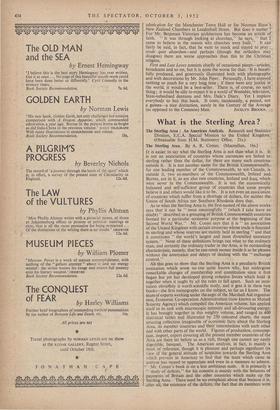Credo Quia Absurdum
First and Last Loves. By John Betjeman. (John Murray. 20s.) WE live, says Mr. Betjeman, in the age not of the Common Man but of the Average Man : " There is a refinement about him which pervades everything he touches and sees. His books are chosen for him by the librarians . . . the walls of his room are in quiet pastel shades, he has cereals for breakfast, and he likes everything in moderation, be it beer, religion or tobacco." It so happened that I read the first chapters of this book travelling down from London to Canterbury on what used to be the old South Eastern and Chatham Railway ; and, as the train sped through those eerie and disquieting suburbs which, as Mr. Betjeman says, " once seemed to me so lovely with their freckled tennis-girls and their youths in club blazers," I too sighed for the yapping Sealyhams (" mind the terrier when you call "), the calceolarias and the clean-limbed, Rossall-or-Repton heroes of my youth. For Ghastly Good Taste has triumphed all along the line (and not only the S.E. & C.R.) ; the tennis-girls are " taking up " ballet-dancing, Van Gogh reproduc- tions have replaced those jolly little sketches of Clovelly which the Mater dashed off on her honeymoon, the spiky and incense-haunted glories of St. Aidan's have made way for the tumescent Romanesque of the Church of Christ Scientist. An age has passed—but its passing has at least been justly celebrated by one of the most original and gifted poets of our time ; and in this book, as in his poems, Mr. Betjeman has captured once•again the very spirit and essence of that vanishing world.
Many of these essays are, as one would expect, about architecture. Mr. Betjeman dwells lovingly, as he has done before, upon the Zion chapels, the Victorian civic halls and the " undertaker's Gothic " which were his first loves. Architecur remains his chief source of inspiration ; yet he is no less happy in the evocation of landscape and atmosphere—" the smells of wood-smoke and fungus in the lanes " in November, the brooding melancholy of Bodmin Moor (" that sweet brown home of Celtic saints "), or the tar-smelling, coniferous glooms of darkest Surrey. The secret of his so-extra- ordinary genius lies, I think, in his ability to look at architecture with the eyes not only of an aesthete but of a lyrical poet ; his vision of the building itself, so acutely and rewardingly perceptive, is mingled always with a wider apprehension of its place in the landscape and in the lives of the people for whom it was built. It has been said of Mr. Betjeman that his tongue, at one period, became so firmly wedged in his cheek that he has never been able to get it out again. It may well be true ; not everyone, certainly, will share his whole-hearted
admiration for the Manchester Town Hall or for Norman Shaw's New Zealand Chambers in Leadenhall Street. But does it matter ? For Mr. Betjeman Victorian architecture has become an article of faith. " It was through looking at churches," he says, " that I came to believe in the reason why churches were built." It can fairly be said, in fact, that he went to mock and stayed to pray : credo quia absurdum—and perhaps (though the orthodox may disagree) there are worse approaches than this to the Christian religion.
First and Last Loves consists chiefly of occasional pieces—articles, broadcasts and so on, but it is none the worse for that. /It is beauti- fully produced, and generously illustrated both with photographs and with decorations by Mr. John Piper. Personally, I have enjoyed nothing so much for a very long time ; if there 'Were any justice in the world, it would be a best-seller. There is, of course, no such thing ; it would be silly to expect it in a world of Weetabix, television, State-subsidised dentures and Mrs. Dale's Diary. Yet I implore everybody to buy this book. It costs, incidentally, a pound, not a guinea—a nice distinction, surely in the Century of the Average (as opposed to the Common) Man. JOCELYN BROOKE.



















































 Previous page
Previous page